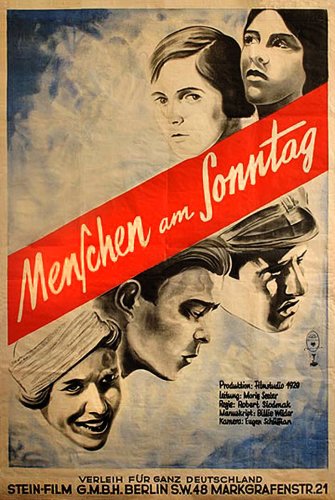

Directed by Robert and Curt Siodmak from a screenplay by Billy Wilder, and with the participation of Edgar G. Ulmer, MENSCHEN AM SONNTAG is a drama filmed over four Sundays in 1929, involving a series of young men and women who flirt with one another, spend time at the beach, enjoy the pleasures of the recreational areas in and around Berlin, and resolve to meet the next Sunday.
It all started in a Berliner café where a bunch of young wannabe filmmakers were regularly meeting to chat about how movies were looking like and how they should look. It was 1929 and their feeling was that German expressionism had already given all that it could give.
And this movie by Curt and the Academy Award nominated Robert Siodmak is too, at least to some extent. It is a fairly chilly watch as we witness how a couple young Germans spend their weekend at the lake and enjoy their free time.
This silent semi-documentary boasts quite a remarkable roster of young talent behind the camera: Billy Wilder, writing his first screenplay; Curt and Robert Siodmak at the helm, aided by contributions from Edgar G. Ulmer and Fred Zinnemann – all of them still in their twenties, all at the beginning of notable careers.
This is probably my 6th favourite Silent Film of all time.The List:1.
A German silent curio heralds several future magnates of the film industry in Hollywood, PEOPLE ON Sunday is the debut feature for both its directors Robert Siodmak and Edgar G. Ulmer, with a script from a tender-age Billy Wilder and Fred Zinnemann in the camera branch.
Edwin, a taxi driver, lives with Annie, a neurasthenic model. They plan to spend Sunday at the Nikolassee beach with Wolfgang, an officer, gentleman, antiquarian, gigolo, at the moment a wine salesman.
One of the surprising things about this film is the very acute, naturalistic and fundamentally humorous performances from an amateur cast, lacking all the usual strange, exaggerated mannerisms of silent cinema. The other impressive aspect of the film is the beauty of the photography, always playful and probing: the scene where an old man responds to the pompous nationalistic statues in the park is brilliant and affecting, if rather ambiguous.
Some of the people commenting on this movies mention the fact that it was made only three years before Hitler came to power. While this is true, it is a historical misunderstanding to think that in 1929, when the film was conceived and shot, Hitler was inevitably looming at the political horizon in Germany.